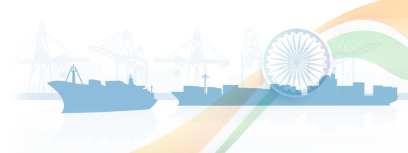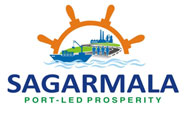National Logistics Platform (NLP) Marine
Abstract
To drive transformation of the logistics sector and to make supply chains productive and competitive and to develop logistics services industry, it is proposed to set up a National Logistics Platform, which can achieve significant outcomes in the immediate to short term and at a fraction of investment and in an integrated manner.
The NLP is being developed with the following key objectives.
-
Ease of Doing Business – Get India to be the one of the most cost effective plus competitive countries in terms of carrying international trade.
-
Transparency – Enables access to information across the supply chain for all stakeholders.
-
Remove Bottlenecks – Caused by lack of timely and date visibility.
-
Empower end users – With real-time decision-making tools.
NLP is a cloud based platform that will collect, collate and integrate information and data on cargo and vehicle flows, capacities and logistics asset availability across the Landside Logistics network through various technologies and across modes.
The data / information, analysis and insights generated can be monetised to support the sector and bring in transparency, remove information asymmetry and other barriers and carryout user defined tasks.
NLP will also support other policy and regulatory processes and compliances and potentially revenue functions.
Key outcomes that NLP will drive
With the ability to integrate, collect and analyse freight flows (other flows), generate user defined insights and tasks, NLP will support the following key interventions in the logistics sector in India:
-
Planning, policy and investment decisions: Help policy and decision makers to understand emerging demand and consumption centres and patterns, network capacity and drive investments, interventions and allocate capital in an efficient manner. For instance, which mode will be better suited to address emerging demand.
-
Resilience and disaster response and management: In scenarios of disasters and emergencies, ability to drive emergency response in a timely and effective manner and build resilience. For instance, where the assets are available and which assets are better suited / placed to reach disaster sites / areas.
-
Multi Modal Integration: Allow modes to be integrated – air, rail, roads, ports, inland waterways etc, including existing asset base (multi-modal logistics parks, warehouses, CFSs / ICDs etc.) leading to better asset utilisation, first mile last mile connectivity and drive enhanced profitability and productivity in the sector, among other benefits.
-
Competitive and productive supply chains: ability to understand flows, integration and availability of assets / modes allows cargo owners, shippers, freight forwarders, 3PL / 4PL players etc to better design supply chains and transport solutions leading to reduced costs, time and enhanced inventory management, productivity etc. For instance, digitisation and platform can allow reduction in port congestion as shippers and transporters can better manage timing of cargo evacuation.
-
Ecosystem support and development: Sharing of information with smaller players, including track and trace services and other value added services to smaller players creates a level playing field and also allows development / Uberisation of supply chains/ consolidation / development of logistics start ups on the back of the platform and the information available.
-
Data monetisation and transparency: The data, adhering to privacy laws and through anonymisation, can be monetised and made available to various stakeholders and help make the platform financially self sustainable.
-
Regulatory compliance / EODB: Integration with GSTN, VAHAN, SARTHI, customs and other related platforms would further enhance visibility and risks in the system, improve compliance and reduce revenue leakages among other benefits
History
The National Logistics Portal is originally to be developed by the Ministry of Commerce. Upon presentation from IPA to Special Secretary Logistics, SSL has advised to bootstrap the existing PCS 1x into NLP Marine. For this budgetary support of INR 10 Crores has been provided by Logistics Department, MoC.
Further then IPA Chairman discussed idea of the National Logistics Portal Marine with the trade associations comprising of the representatives of FILA, MANSA, CSLA, CFSAI, IPPTA, FIEO, representatives from Ministry of Railway, Customs for the Vision 2030. In the various meetings conducted during month of May 2020 the scope of NLP Marine was deliberated and finalized.
Based on inputs from the deliberations with the trade IPA has published the RFP on 28th September 2020. For this project IPA has appointed EY as PMU. In the corrigendum V of the RFP dated 19th Nov 2020 was published with the revised requirements of the RFP.
Consortium with lead bidder M/s DP World and M/s Portall Infosystems submitted the bids for the tender. M/s Portall Infosystems was selected for the work for the tender.
IPA has entered into agreement with M/s Portall Infosystems Pvt Ltd on 5th April 2021.
Functionalities of NLP Marine
NLP Marine is designed as an “open platform” and in a manner that allows coexistence of multiple service providers to provide EXIM related services independently or by using connectivity options and data as authorized by IPA.
The design enable business users to amend and manage business rules relating to routing of messages, workflows etc. through a suitable rules engine and service catalogue should be configurable; without the aid of technical personnel.
The NLP Marine is highly configurable through dynamic forms, list grids, layouts etc. Changes to these components is achievable without code modification. For example, all list grids provide selectable fields to be displayed, export to excel/ pdf/ print/ XML function, filtering etc. which is configurable. New changes on existing modules is faster to incorporate and mostly achieved with minimal code changes. E.g. adding a new field to an existing form is more of a configuration.
The proposed solution have the capability to integrate with various Port Operating Systems/ Terminal Operating Systems and other stakeholder(s) systems in the ecosystem.
The NLP Marine have provisions for translating messages of different standards (EDIFACT, XML, ANSI etc) to facilitate meaningful exchange of messages with multiple external systems in required formats.
The NLP Marine shall have the functionality and features such as message transmission, message translation, authentication and authorization, single sign-on, communication gateway, customer management system (CMS) & component of event handler. The data transacted by the stakeholders must be through Digital Data Exchange (hereinafter referred as DDx) module of NLP Marine. The stakeholder needs to have requisite hardware / software as specified by the IPA.
Architecture is scalable (to cater to increasing load of internal and external users and their transactions) and capable of delivering high performance for the entire life cycle of the applications.
Data model, interface designs, and other components are designed as per industry standards and best practices.
Solution design included, the design of the application architecture, user interface, database structures, security architecture, network architecture, deployment architecture etc.
The components/ services are designed in a manner that ensures ease of implementation and maintenance.
The proposed solution is able to scale up for user volume, data volume, transaction volume and functionality; as and when required.
The proposed solution is complying with security guidelines as defined and required by the Government of India.
In view of the conceptual framework of NLP Marine , The platforms becomes the central hub in all interactions with various stakeholders viz. Port, Terminals Shipping Lines/ Agents, CFS and Customs Brokers, Importer / Exporter etc. These interactions are expected to take place in real time. The communication among the stakeholders will be fast, reliable, recordable and device independent. Furthermore, system is able to provide audit trail of all processed transactions.

Cargo Service Platform:
-
The services under this platform are related to the activties of the Cargo / Goods
-
This services includes activities which are perfomed at Custodians’ premises, such as Port / Terminal / ICD / CFS etc
-
Other than the custodian services, operations performed at the Warehouses are covered
-
Activities / services for handling non-contenarized cargo are included in the same
Regulatory Bodies and PGAs Service Platform
-
Functionality which is performed with Regulatory authorites such as Customs are included.
-
Certain information which is share by Customs will be visible on the NLP platform
-
Application of IEC and other applucation for procuring other licences will be provided
-
Comodity-specific bodies such as FASSAI / Coffee Board / Textile Committee etc can provide ceritifcate / clearance for the shipments
Carrier Service Platform
-
Activities related with Shipping Lines / Shipping Agents / Airlines are included
-
Shipping inclues EXIM as well as Coastal movement
-
Inland Waterways will be integrated to provide their services on NLP Marine
-
Services such Container Booking / Slot booking can be performed
-
Services involved under Rail / Road movement of goods will be avaiable
Banking and Insurance Service Platform
-
Transaction activites such as e-payments to any stakeholder within the system will be available
-
Services offered by Bank such as LC process, Bank Gurantee Process can be done
-
Reconcialiation service to benefit the Services provider and consumer for easy tracking of the payment history and faster reconciliation process
-
Onboarded Insurance providers to provide insurance for Domestic / Internation transportation of Cargo
Implementation Mehtodolgy
As per the instructions of IPA, the team has put together an implementation plan commensurate with the idea of an iterative implementation strategy. This allows for showcasing successes at a regular interval; a sum-of-parts approach.
This approach furthermore ensures that NLP Marine has a faster time to market as well as ensure continuous improvement in the platform.
Since this is a deviation from the implementation schedule and delivery milestones, as envisaged in the tender document, m/s Portall has been instructed to submit a formal letter to the IPA encompassing the new details, for due approval.
The following activities shall be carried out on a continuous basis during every iteration:
Requirement Gathering
-
Information gathering through market research and stakeholder interactions.
-
Questionnaires and interviews
Process Synchronisation
-
Synchronisation of various processes, mapping the same with RFP requirements and integration mapping between various modules.
-
Documenting the as-is and to-be processes.
Documentation
-
Process flows
-
Gap analysis
-
BRS and SRS preparation.
-
Sign-off from committees, and IPA.
Development
-
Phase wise development and delivery as per the timelines.
LSP Identification
-
Identification of latch-on service providers.
-
Demo sessions, SOW and agreement signing.
-
Onboarding, testing and integration.
API
-
Deployment of API gateway
-
Integration and testing with stakeholders / latch-on service providers.
Stakeholder onboarding
-
Training session
-
User manual
-
Video Tutorials
-
Platform demonstrations
Final delivery
-
Iteration to iteration synchronisation so as to deliver a seamless platform covering all the functionalities.
Customer Support
The below activities will be carried out for Customer support, which will be implemented from the first (1st) iteration itself:
-
Setting of Support desk
-
Communication matrix
-
User awareness
Release Timelines:
The various iterations, their timelines and the functionalities are as following:
Iterations: (T= 15th July)
The various iterations, their timelines and the functionalities are as following:
Iteration 1: T+ 80 Days
• Registration + Login Module
• Landing Page Incl. of Search
• Service Catalogue
• Common Application Form (CAF) module
• Transport Module
• Booking Module
• e-VGM module
• Business Transactions Support (Grievances) module
Iteration 2: T+6 months
• e-SEAL Module
• Finance Platform
• Insurance Platform
• Documents Exchange Module
Iteration 3: T+7.5 months
• Empty Yard Module
• Warehouse Module
• Freight Forwarder Module (Full Service)
• Route Planning Module
• Admin Config Module (Profile Extension)
• Content Management
• Vendor Management
Iteration 4: T+9 months
• Packaging service provider
• Dashboard, Analytics and MIS
• Generated Certificates Module
• Integrated PGA EPC Platform Module
Iteration 5: T+11 months
• Port Module (PCS 1x - Trade)
• E-Berthing Module
• Terminal Module
• Track and Trace Module
• Order Management
• Ratings Module
• Listing Module
• Integrated Regulatory Platform Module
Iteration 6: T+12 months
• Coastal Module
• Rail Module (CTO)
• Shipping Line Module
• Inland Waterways Module
• CFS Module
• ICD Module
• Mobile App
Current Status
-
Agreement Signing 15th April 2021
-
Kick off 15th April 2021
-
Requirement Gathering meeting carried out till date with following organisations
-
NISSA
-
NACFS
-
MANSA
-
CSLA
-
CFSAI
-
AMTOI
-
ACTO
-
CDSCO
-
PLEXCON
-
AQCS
-
WCCB
-
Cotton Textile EPC
-
Tea Board
-
Tobacco Board
-
Service EPC
-
PEDEXICL
-
MPEDA
-
Spices Board
-
Shellac EPC
-
Pharma EPC
-
Jute EPC
-
FIEO
-
Deliverables as milestone D2, D3, D4, D5-1 submitted and under review.
-
Project Charter
-
Detailed Project Plan
-
Master Design Document
-
Detailed BRS
-
SRS for Iteration 1
-
PMIS
-
Release Management
-
Modules under Iteration 1 apart from grievances module has been delivered on testing environment by the service provider





 मुख्य विषयवस्तु में जाएं
मुख्य विषयवस्तु में जाएं












